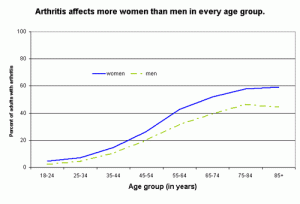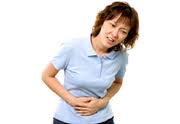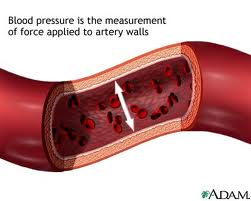 In 2006, the Center for Disease Control and Prevention (CDC) reported that 21.6% of the US adult population reported arthritis, with significantly higher prevalence in women than in men (24.4% vs. 18.1%). Arthritis prevalence increased with age and was higher among women than men in every age group. With the aging of the US population, the prevalence of doctor-diagnosed arthritis is expected to increase in the coming decades. By 2030, it is estimated that 67 million adults age 18 and older will have arthritis, compared with the current 46 million. Also, by 2030 an estimated 25 million adults will report arthritis-attributable activity limitations.
In 2006, the Center for Disease Control and Prevention (CDC) reported that 21.6% of the US adult population reported arthritis, with significantly higher prevalence in women than in men (24.4% vs. 18.1%). Arthritis prevalence increased with age and was higher among women than men in every age group. With the aging of the US population, the prevalence of doctor-diagnosed arthritis is expected to increase in the coming decades. By 2030, it is estimated that 67 million adults age 18 and older will have arthritis, compared with the current 46 million. Also, by 2030 an estimated 25 million adults will report arthritis-attributable activity limitations.
Functional limitations in routine activities are common among adults with arthrtis: 40% report it is "very difficult" or they "cannot do" at least 1 of 9 important daily functions which include their ability to stoop, bend, grasp, kneel or walk 1/4 mile. Obesity is a known risk factor for the progression of knee osteoarthritis and possibly of other joints. Reducing body weight may result in significant improvement in the health-related quality of life of people with arthritis.
Although physical activity and exercise have been shown to benefit people with arthritis by improving pain control, function, and mental health, many people with arthritis report no leisure time physical activity. Low levels of physical activity place individuals with arthritis at further risk of inactivity-associated conditions such as cardiovascular disease, diabetes, obesity, and functional limitations.
Some interesting research is currently taking place at Northwestern U. that is looking at knee alignment and its role in progression of knee osteoarthritis that could lead to earlier and novel interventions that could decrease or prevent arthritic disability in the future. Many Illinois women who are part of the Illinois Women's Health Registry are participating in those studies.
In the meantime, women (and men) who have arthritis could benefit from keeping their weight down and keeping physically active!!! As we age, it is even more important that we develop a lifestyle that includes healthy eating and exercise.

 A study by researchers at the National Institutes of Health (NIH) and the University of Oxford supports the widespread belief that stress may reduce a woman's chance of becoming pregnant. The study is the first of its kind to document, among women without a history of fertility problems, an association between high levels of a substance that is indicative of stress and a reduced chance of becoming pregnant.
A study by researchers at the National Institutes of Health (NIH) and the University of Oxford supports the widespread belief that stress may reduce a woman's chance of becoming pregnant. The study is the first of its kind to document, among women without a history of fertility problems, an association between high levels of a substance that is indicative of stress and a reduced chance of becoming pregnant. Results of a recent poll by ICM, a public opinion research firm from England, two thirds of the British public and nearly nine out of 10 (88%) of 18-24 year olds are unable to name a single famous female scientist, despite scientists being viewed as a good role model. The
Results of a recent poll by ICM, a public opinion research firm from England, two thirds of the British public and nearly nine out of 10 (88%) of 18-24 year olds are unable to name a single famous female scientist, despite scientists being viewed as a good role model. The  A recent Food and Drug Administration (FDA) MedWatch Safety Alert warns women to make sure children and pets do not come into contact with Evamist that they have sprayed on their skin. Evamist is a transdermal spray containing estradiol, a form of estrogen. It is sprayed inside of the forearm between the elbow and wrist to reduce hot flashes during menopause. Each squirt of spray delivers 90 mcL which contains 1.53 mg of estradiol and is FDA approved for this use.
A recent Food and Drug Administration (FDA) MedWatch Safety Alert warns women to make sure children and pets do not come into contact with Evamist that they have sprayed on their skin. Evamist is a transdermal spray containing estradiol, a form of estrogen. It is sprayed inside of the forearm between the elbow and wrist to reduce hot flashes during menopause. Each squirt of spray delivers 90 mcL which contains 1.53 mg of estradiol and is FDA approved for this use. Study finds association between stress level in early cycle, severity of symptoms
Study finds association between stress level in early cycle, severity of symptoms No, you did not open the wrong page. Yes, this blog is posted by the
No, you did not open the wrong page. Yes, this blog is posted by the  Low testosterone levels to blame for low libido, fatigue and weight gain
Low testosterone levels to blame for low libido, fatigue and weight gain Middle-aged and elderly Swedish women who regularly ate a small amount of chocolate had lower risks of heart failure risks, in a study reported in Circulation: Heart Failure, a journal of the American Heart Association. The nine-year study, conducted among 31,823 middle-aged and elderly Swedish women, looked at the relationship of the amount of high-quality chocolate the women ate, compared to their risk for heart failure. The quality of chocolate consumed by the women had a higher density cocoa content somewhat like dark chocolate by American standards. In this study, researchers found:
Middle-aged and elderly Swedish women who regularly ate a small amount of chocolate had lower risks of heart failure risks, in a study reported in Circulation: Heart Failure, a journal of the American Heart Association. The nine-year study, conducted among 31,823 middle-aged and elderly Swedish women, looked at the relationship of the amount of high-quality chocolate the women ate, compared to their risk for heart failure. The quality of chocolate consumed by the women had a higher density cocoa content somewhat like dark chocolate by American standards. In this study, researchers found: All living organisms have a circadian clock, sometimes called a biological clock, that is an important part of maintaining optimal health. The circadian rhythm is a roughly 24-hour cycle in the biochemical, physiological, or behavioral processes of living things. Although circadian rhythms originate from within our bodies, they are synchronized to the environment by external cues, including the day-night cycle caused by the Earth's rotation. Researchers are looking more closely at the role circadian rhythms play in the development of diseases such as breast cancer and also how factors such as hormones affect this biological clock.
All living organisms have a circadian clock, sometimes called a biological clock, that is an important part of maintaining optimal health. The circadian rhythm is a roughly 24-hour cycle in the biochemical, physiological, or behavioral processes of living things. Although circadian rhythms originate from within our bodies, they are synchronized to the environment by external cues, including the day-night cycle caused by the Earth's rotation. Researchers are looking more closely at the role circadian rhythms play in the development of diseases such as breast cancer and also how factors such as hormones affect this biological clock. Postmenopausal women have an increased risk of hypertension (high blood pressure), and among older adults, more women than men have hypertension. As with many other health issues, hypertension research has been conducted predominately in males, and little is known about how women's bodies manage blood flow. Research conducted by Heidi A. Kluess at the University of Arkansas is focusing on a better understanding of hypertension in women by using a new technique to examine the release of a neurotransmitter in small blood vessels.
Postmenopausal women have an increased risk of hypertension (high blood pressure), and among older adults, more women than men have hypertension. As with many other health issues, hypertension research has been conducted predominately in males, and little is known about how women's bodies manage blood flow. Research conducted by Heidi A. Kluess at the University of Arkansas is focusing on a better understanding of hypertension in women by using a new technique to examine the release of a neurotransmitter in small blood vessels. The most recent statistics on the women who participate in our
The most recent statistics on the women who participate in our